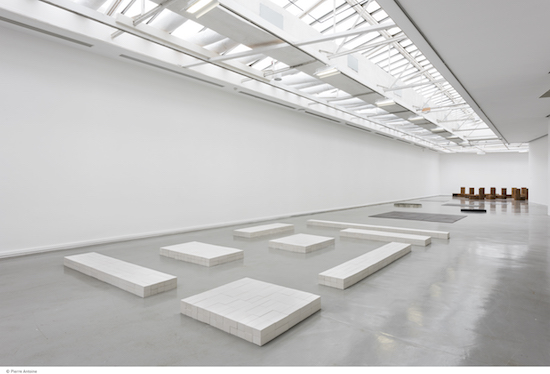All images: Vue de l’exposition, Carl Andre: Sculpture as Place, 1958–2010 au Musée d’Art moderne de la Ville de Paris. © Pierre Antoine
Few works of contemporary art are as recognisable as Carl Andre’s Equivalence VIII. A double-height 6×10 grid of beige bricks, 120 in all. Bought in 1972 and exhibited for four years without fuss when a Sunday Times article about recent Tate acquisitions threw it into the media spotlight. Their article, stating that nearly £3,000 of public money had been spent purchasing it, was seized on and regurgitated by tabloid and local newspapers in equal measure of mock, rage and mock-rage. It even resulted in one person throwing blue dye all over the piece.
The blue stains were cleaned off to reveal the original sand-lime colour and it was re-installed in 1977 with queues to see it, an important element in the Tate archive through to the present day, where it holds prime position in the new Switch House extension.
The similar-but-different work in the Paris exhibition is Sand-Lime Instar, made much later in 1995. Also 120 beige bricks, but these formed in a long double-height row of 60 bricks dividing up the gallery space, an echo of the Tate piece.
The Tate Equivalence VIII was itself an echo. The original Equivalence, one of a group of eight configurations of 120 bricks, was made for Andre’s second solo show in 1966. Eight configurations of a mass carefully formed and interrelated to fit into New York’s Tibor de Nagy gallery. Made from a New York brickworks, the scale, order and form of the work was developed in situ by the artist who worked with and against the architectures he was asked to work in.
The gallery never sold the works, so the bricks were returned to the brickworks and Andre got his cash back. By 1969 he was a flying higher and sought to re-make the works. Though the brickworks had closed down he sourced similar from elsewhere, and it was this work of a different material, and just one of a connected series of eight which would never be housed in the site specific space it was created for, and which Tate bought.
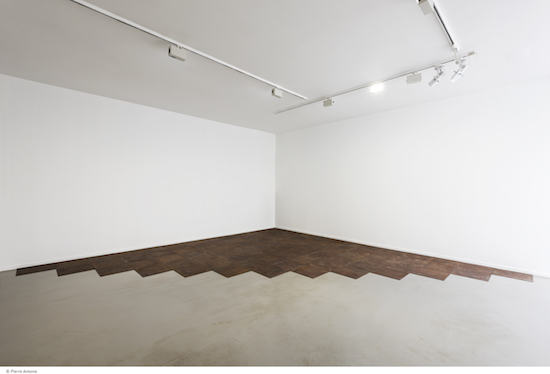
Here lies the core of the main issue with not only this Musée d’Art Moderne retrospective but most installations of Andre’s works – they were all deeply site-specific works which, once moved into new contexts, become colder and less rooted. Even though the original brick was a commercial object, it was still a locally sourced material and a product of the land and environment the work was made for. Even if the original gallery was white walled and rectangular, the proportions and volume directly informed the way Andre created the work on site.
At least the Tate shadow-version has, through that drama of opposition and blue dye, created its own historical narrative as a root. The work may have lost its shock after moving from the neoclassical surroundings of what is now Tate Britain to become somewhat assimilated into the brick architectures of Tate Modern’s Boiler House and now the new Switch House. But in the Tate curation it is at least given strength by being related to other thematically connected work. The Paris shadow-shadow-version only curatorially serves in the linear relationship of his own practice. All context is lost in this show. It just feels so isolated from the world outside, the world in which it was created, the art history in which it sits, other artists, the real world, location, context. And context is all when it comes to Andre. Because without it, you are simply reduced to form and the fetishisation of a minimal aesthetic.
This is fine to some extent. The exhibition is beautifully arranged and many ‘big hits’ are included – this is a super-show which started in New York before hitting Madrid and Berlin, next to be shipped off to LA.
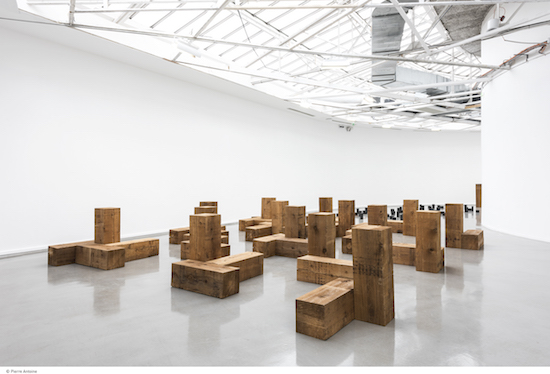
The ‘big hits’ are quite literally big – this exhibition, whichever world-city it lands in, needs a big space. But it starts small: Andre’s early works included small and formal studio studies, photographed experiments dealing with material and relationships made between 1958 and 1961. Then there are smaller sculptural works made when he could not afford a studio, comprising found materials, sometimes from his day-job as a freight brakeman on the Pennsylvania Railroad, simply leaning against one another as spatial games, playful assemblages.
Also included are other smaller works which Andre started in these early years but carried on making throughout his career. Text and typography, poetry and his ‘Dada forgeries’, small sculptures of found objects humorously and absurdly juxtaposed against one another. These are subtle, often very intelligent, sometimes trite, but always experimental and joyful. There is a real connection here between the artist and the work, one can sense his hand manoeuvring them into place, finding the relationship that clicks.
This hands-on craft is also present in his larger works, made from the mid 60s onwards. These developed over the years and are the most recognisable of Andre’s output: systematic and regimental use of industrial materials, employing structural language and repetitive spatial relationships. They form the larger part of the show and in places are aesthetically wowing.
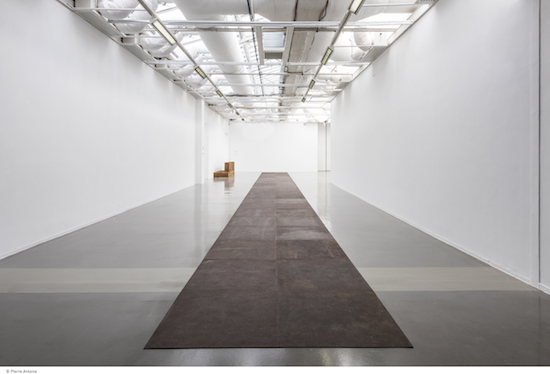
Still they feel cold. And they don’t feel cold for the same reasons the tabloid-provoked protestors at Tate in the 70s thought, “because they’re just bricks” (or wood, or concrete, etc) but because they feel homeless and detached. These architectural scale works are lost from the architecture they were made for and made in. Because of that they feel more like symbols than artworks.
There is one noticeable exception, Ferox, a 1982 work simply comprised of 91 square steel floor tiles triangulated into the corner of a room. It works so well because of the arbitrary and accidental architectural details in the space it relates against – an air ventilation grille, a thermostat, the skirting and a security sensor. The curator has here acknowledged and allowed the idiosyncrasies of the space to mingle with the work, and it has more in common with the approach Andre took when first installing his pieces.
After Ferox the works begin to decrease in scale through the show, in the end returning to the smaller hand-formed pieces that Andre’s career started with. Since 2010 he has not been producing larger works, but hand and mind are put to use with much the same approach for these table-top works. They are made for pleasure, rather than commission or exhibition, and are in many ways richer and more profound because of it.
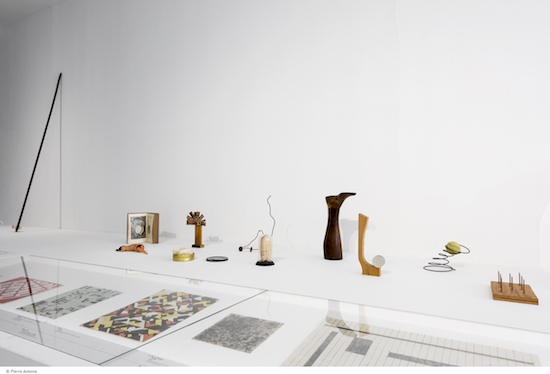
The whole exhibition floor does a circuit, meaning that the exit is the same door as the entrance, and the room with his end-of-career small works in adjoins the opening room with his early-career small works. A rather poetic and meaningful return and a pleasing arc for the exhibition visitor. But come the end I felt a kind of emptiness, a total lack of attempt by the curator to lock this artist, his work and language into any kind of context.
Included are three videos featuring Andre in discussion and installing his work in a gallery which offered valuable and rich insight into the man, as well as a photographic series of his hometown, Quincey, illustrating some connection to the raw materials and industrial landscapes which informed his work. Arguably these elements are the most interesting and informative parts of the show, certainly they are the only moments that offer anything in the way positioning the sculptures a visitor walks around with wider ideas and processes which led to them.
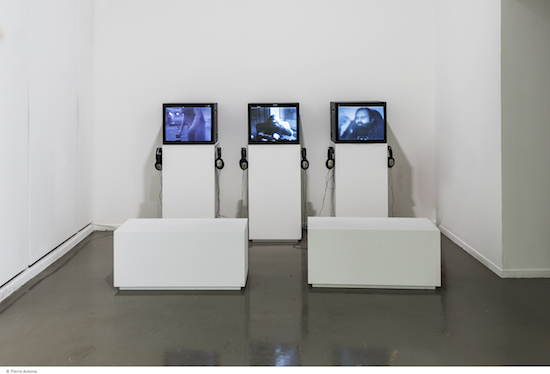
But besides these videos and prints there was a lack of contextualising his career and work into the outside world, politics, art or culture. There was scant reference to any other artist and the fact that no mention was made of Ana Mendieta, artist and Andre’s wife of eight months before her untimely death from a 33 floor fall for which Andre was tried in court for, is plain bizarre. What results is a visually impressive display of rather flat symbols to themselves, lacking warmth or depth.
The big-hitters of this show includes some beautiful aesthetic moments. But the real moments of this show were in the smaller, more delicate and intimate works where, in the absence of any curatorial effort to give context to the large works, a sense of the man and his touch could really be felt.
Carl Andre, Sculpture As Place, 1958-2010, is at the Musée d’Art Moderne, Paris, until 12 February 2017

